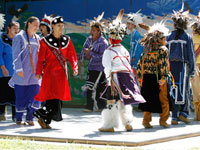Fort Stanwix National Monument [NY]
The Fort Stanwix National Monument presents the fort's Revolutionary War history and its impact on the history of New York settlement. Collections consist of more than 476,000 artifacts. Three trails circle the fort. One follows the Oneida Carrying Place, while the other two interpret the siege of 1777. During the seige, Colonel Peter Gansevoort maintained control of Stanwix despite the concentrated British, Loyalist, German, Canadian, and Native American troops which surrounded the structure, earning it the nickname of "the fort that never surrendered." This victory is one of several which eventually led to political alliances with The Netherlands and France. The fort is located on traditional Oneida lands. The Oneida Carrying Place is an over land route between Wood Creek and the Mohawk River.
The monument offers an orientation talk, three trails, exhibits, guided curriculum-based educational programs, self-guided fort tours, audio-visual displays, weapons demonstrations, guided tours, living history programs, an activity for three through six year olds, Junior Ranger activities, and an area for building model forts. Reservations are required for all guided programs. The website offers lesson plans, a 1777 campaign Revolutionary War map, a word match, a crossword puzzle, a word search, and suggested reading lists for students and teachers.
